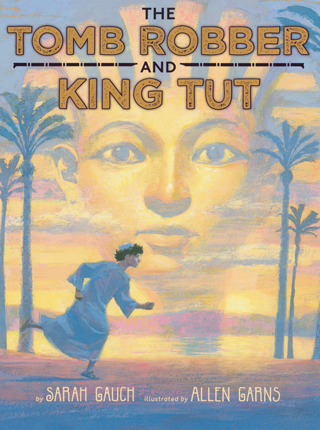| Tomb robber and King Tut Author: Gauch, Sarah | ||
| Price: $6.50 | ||
Summary:
Hassan, grandson of tomb robbers, joins the dig of King Tut's tomb, but must show honesty to continue working.
| Illustrator: | Garns, Allen |
Reviews:
Kirkus Reviews (04/15/15)
Booklist (07/01/15)
The Bulletin of the Center for Children's Books (A) (09/15)
Full Text Reviews:
Booklist - 07/01/2015 Set in November 1922, when King Tut’s tomb was discovered in Egypt, Gauch tells the fictional story of a boy who helped clear the path to the tomb’s doorway. As the book opens, Hassan is enthralled by the work being led by British archaeologist Howard Carter, but he is prevented from helping by several circumstances. His grandfather was a tomb robber, who sold treasures in order to feed his family, and Hassan’s father insists that Hassan pursue the honorable work of farming with him. The book itself seems to come from another era, as do Garns’ illustrations, which hearken back to the drama and movement of N. C. Wyeth’s work and convey the adventurous spirit of children like Hassan. The boy is not dissuaded by either bad omens or hard work, and Gauch rewards him with one of the first sights of King Tut’s tomb and the satisfaction of redeeming his family name. An author’s note offers additional details on Carter’s excavation. A lovely look at one of Egypt’s greatest discoveries. - Copyright 2015 Booklist.
Bulletin for the Center... - 09/01/2015 In 1922, English archaeologist Howard Carter is on the verge of a great discovery in Egypt’s Valley of the Kings, and a young boy, Hassan, has been invited to work on the excavation. Hassan’s father is set against it, preferring that his son not become involved in activities that are associated with their community’s reputation for tomb robbing. Hassan’s exemplary behavior wears his father down, though, and the boy joins the dig as a basket carrier, hauling loads of sand from the site. As his father predicted, the overseer calls him “tomb robber,” but Hassan persists and manages to be right at Carter’s side when he holds his candle to the hole in Tutankhamun’s burial antechamber for the first glimpse of “wonderful things.” The story makes central an issue little examined in children’s literature, the community at Gurna and their reputation for tomb robbery; however, the device to bring Hassan to the fore is hackneyed, and the book opens the issue of the Gurnawis without really examining it. The illustrations, saturated gouache with pastel textures, are atmospheric, but they’re occasionally misleading; Lady Herbert (clearly alluded to in the text) is missing from the climactic scene, and an impossible glow emanates from the antechamber to illuminate Hassan’s face. An author’s note is included, but it too leaves much unsaid. This is therefore an interesting if flawed entry to the subject, and alert listeners might propose the uncomfortable question, “Why are the Gurnawis grave robbers, but Carter isn’t?” EB - Copyright 2015 The Board of Trustees of the University of Illinois.



